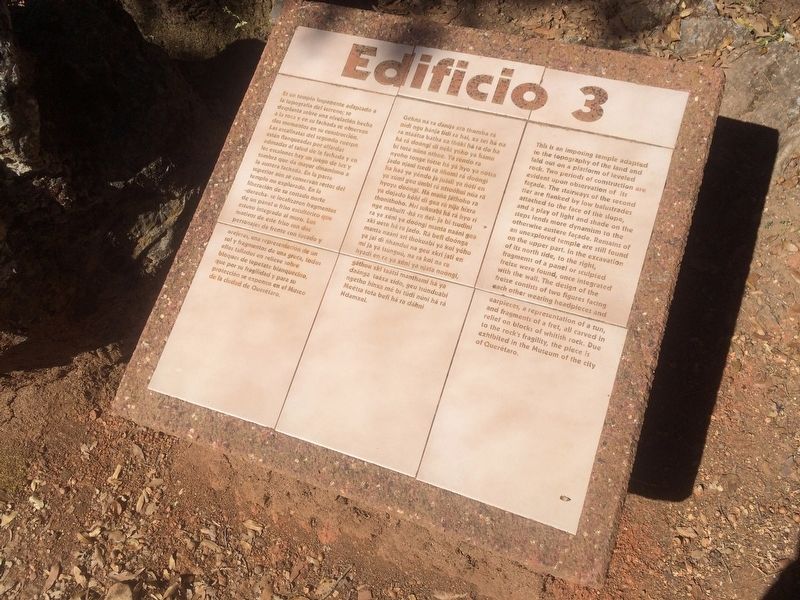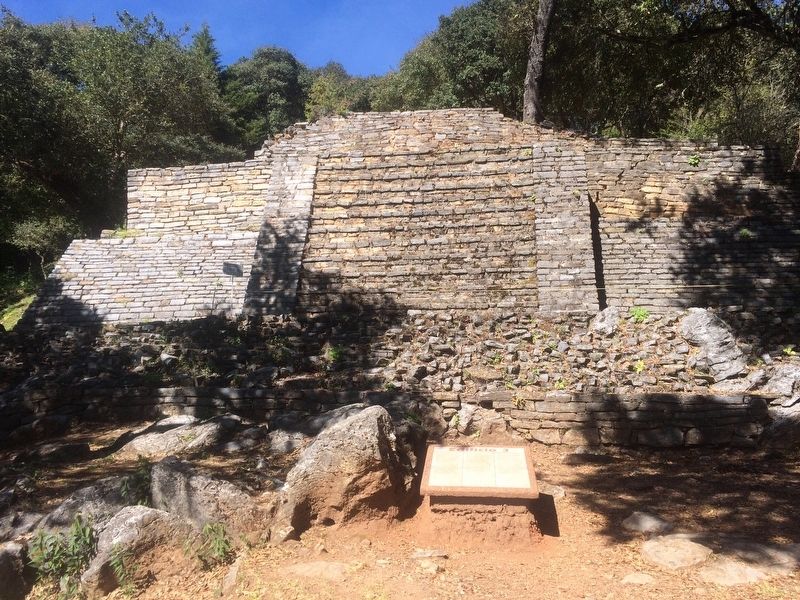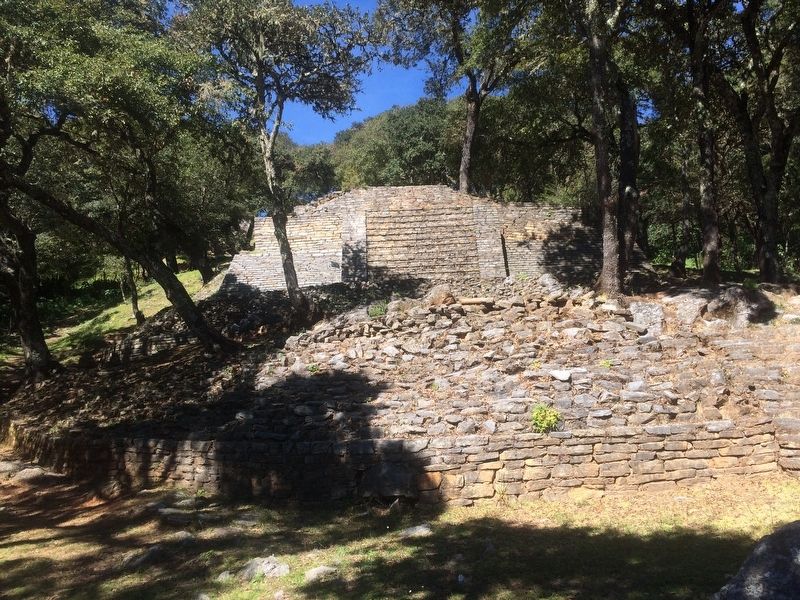San Joaquín, Querétaro, Mexico — The Central Highlands (North America)
Building Three
Edificio 3
Es un templo imponente adaptado a la topografía del terreno; se desplanta sobre una nivelación hecha a la roca y en su fachada se observan dos momentos en su construcción. Las escalinatas del segundo cuerpo están flanqueadas por alfardas adosadas al talud de la fachada y en los escalones hay un juego de luz y sombra que da mayor dinamismo a la austera fachada. En la parte superior aún se conservan restos del templo no explorado. En la liberación de su costado norte – derecha - se localizaron fragmentos de un panel o friso escultórico que estuvo integrado al muro. Los motivos de este friso son dos personajes de frente con tocado y orejeras, una representación de un sol y fragmentos de una greca, todos ellos tallados en relieve sobre bloques de tepetate blanquecino, que por su fragilidad y para su protección se exponen en el Museo de la ciudad de Querétaro.
Edificio 3
Gehna na ra danija xra thomba ra nidi ngu hánja tídi ra hai, xa tei há na ra ntaátsa batha xa thóki há ra do ha há rá doóngi di neli yóho ya hámu bi tote núna nthoe. Yá réndo ra nyoho tonge totse há yá hyo ya nótsa jado njani tsedi ra nhomi rá doongi ha haá ya yéndo ja juádi ya ñóti en ya xúmi geu úmbi rá ntsoóhui núa rá hyoya doongi. Há maña játhoho ra ya dojado kóhi di gea ra nija hixra thonithoho. Mri sukuabi há rá hyo ri nge mahuifi - há ra nei - ja bi tsudini ra ya xéni ya doóngi manta naáni gea xki uéte há ra jado. Rá befi doónga manta naáni xri thokuabi yá koi yóho ya jai di nhandui na geu xkri jati en mí ja yá tsunguu, na rá koi na ra hyadi en ra ya xeni ya njata noóngi, gáthou xki taátsi manthami há ya daánga taáxa xido, geu tsúnduabi ngetho hinxa mé bi túdi núni há rá Meétsa tota befi há ra dáhni Ndamxei.
Building Three
This is an imposing temple adapted to the topography of the land and laid out on a platform of leveled rock. Two periods of construction are evident upon observation of its façade. The stairways of the second tier are flanked by low balustrades attached to the face of the slope, and a play of light and shade on the steps lends more dynamism to the otherwise austere façade. Remains of an unexplored temple are still found on the upper part. In the excavation of its north side, to the right, fragments of a panel or sculpted freize were found, once integrated with the wall. The design of the freize consists of two figures facing each other wearing headpieces and earpieces, a representation of a sun, and fragments of a fret, all carved in relief on blocks of whitish rock. Due to the rock's fragility, the piece is exhibited in the Museum of the city of Querétaro.
Erected by Instituto Nacional de Antropología e Historia (INAH).
Topics. This historical marker is listed in these topic lists: Anthropology & Archaeology • Man-Made Features • Native Americans • Sports.
Location. 20° 55.563′ N, 99° 33.879′ W. Marker is in San Joaquín, Querétaro. The marker is at Ranas Archaeological Site to the north of the town of San Joaquín, on an unnamed but well-known road, near the "Finca de Doña Lore". Touch for map. Marker is in this post office area: San Joaquín QUE 76550, Mexico. Touch for directions.
Other nearby markers. At least 8 other markers are within walking distance of this marker. Ball Court Three (a few steps from this marker); Archaeological Work (within shouting distance of this marker); The Doors of the City (within shouting distance of this marker); The Sunken Patio Complex (about 90 meters away, measured in a direct line); The Buildings 16 and 16-b (about 90 meters away); The City and its Territory/The Inhabitants (about 90 meters away); Las Ranas and the Access Complex (about 120 meters away); Ball Court Two (about 150 meters away). Touch for a list and map of all markers in San Joaquín.
Credits. This page was last revised on January 23, 2018. It was originally submitted on January 21, 2018, by J. Makali Bruton of Accra, Ghana. This page has been viewed 121 times since then and 5 times this year. Photos: 1, 2, 3. submitted on January 21, 2018, by J. Makali Bruton of Accra, Ghana.


